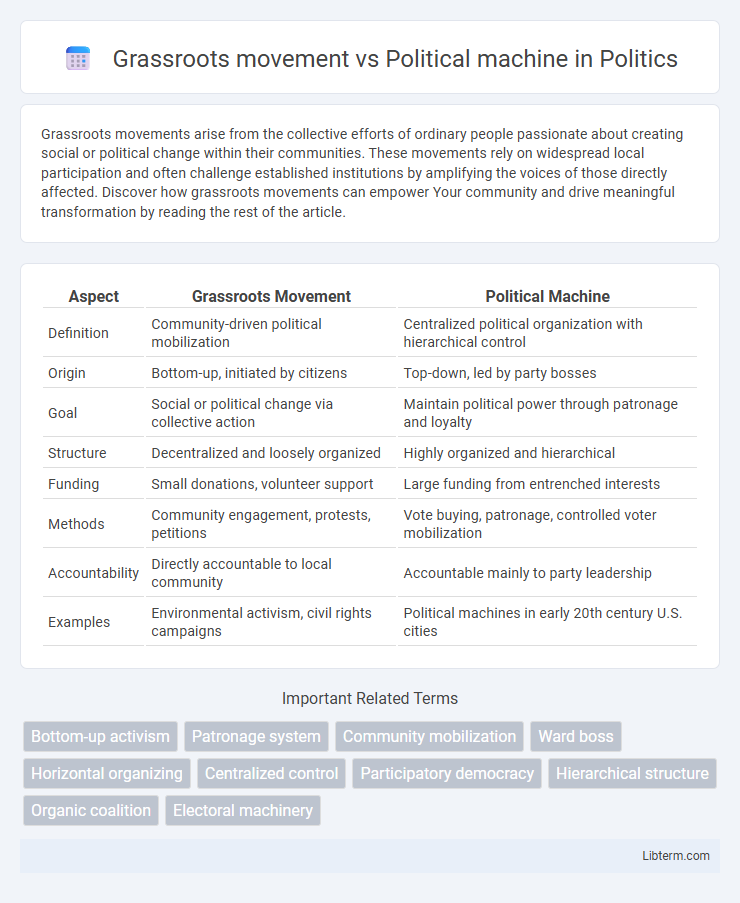Grassroots movements arise from the collective efforts of ordinary people passionate about creating social or political change within their communities. These movements rely on widespread local participation and often challenge established institutions by amplifying the voices of those directly affected. Discover how grassroots movements can empower Your community and drive meaningful transformation by reading the rest of the article.
Table of Comparison
| Aspect | Grassroots Movement | Political Machine |
|---|---|---|
| Definition | Community-driven political mobilization | Centralized political organization with hierarchical control |
| Origin | Bottom-up, initiated by citizens | Top-down, led by party bosses |
| Goal | Social or political change via collective action | Maintain political power through patronage and loyalty |
| Structure | Decentralized and loosely organized | Highly organized and hierarchical |
| Funding | Small donations, volunteer support | Large funding from entrenched interests |
| Methods | Community engagement, protests, petitions | Vote buying, patronage, controlled voter mobilization |
| Accountability | Directly accountable to local community | Accountable mainly to party leadership |
| Examples | Environmental activism, civil rights campaigns | Political machines in early 20th century U.S. cities |
Understanding Grassroots Movements
Grassroots movements emerge from the collective efforts of ordinary citizens aiming to influence social or political change through local, community-based actions. These movements rely on direct participation, volunteerism, and bottom-up organizing to build momentum and shape public policy. Unlike political machines, which operate through hierarchical structures and centralized control, grassroots movements emphasize decentralized leadership and organic growth driven by shared values and interests.
Defining Political Machines
Political machines are organized groups led by a single boss or small group that command enough votes to maintain political control, often relying on patronage, kickbacks, and centralized power. They operate through hierarchical structures designed to mobilize voters and ensure loyalty, frequently exchanging favors or services for political support. These machines contrast with grassroots movements, which arise organically from community involvement and emphasize decentralized participation and empowerment.
Historical Origins and Evolution
Grassroots movements trace their origins to spontaneous, bottom-up efforts aimed at social change, exemplified by the Populist movement in late 19th-century America and the Civil Rights Movement during the 1960s. Political machines emerged in the 19th and early 20th centuries, particularly urban centers like New York City's Tammany Hall, characterized by hierarchical structures and patronage systems that consolidated power through votes and favors. Over time, grassroots movements evolved towards decentralized activism and digital mobilization, while political machines declined due to reforms and anti-corruption measures disrupting their control.
Key Characteristics and Structures
Grassroots movements are characterized by decentralized, community-driven efforts emphasizing volunteer participation and bottom-up decision-making, often emerging organically to address local or social issues. Political machines operate through highly organized, hierarchical structures controlled by a central authority that utilizes patronage, loyalty, and vote mobilization to maintain power within a specific area. While grassroots movements prioritize collective action and democratic engagement, political machines rely on top-down control, strategic resource distribution, and political corruption to achieve and sustain influence.
Mobilization Strategies: Bottom-Up vs Top-Down
Grassroots movements emphasize bottom-up mobilization strategies, engaging community members directly to build support through local organizing, social networks, and participatory decision-making processes. Political machines rely on top-down strategies, utilizing centralized control to mobilize voters via patronage systems, hierarchical leadership, and coordinated campaign efforts. The contrast lies in grassroots efforts fostering organic, inclusive participation, while political machines enforce disciplined, strategic mobilization to secure electoral dominance.
Influence on Policy and Decision-Making
Grassroots movements exert influence on policy and decision-making by mobilizing ordinary citizens to advocate for change, often shaping public opinion and pressuring elected officials through organized campaigns and protests. Political machines maintain control over policy outcomes by leveraging centralized party organizations, patronage networks, and controlled voter blocs to ensure loyal support and maintain power within government institutions. While grassroots efforts foster bottom-up democratic engagement, political machines operate top-down, prioritizing party loyalty and established power structures in policy decisions.
Funding and Resource Allocation
Grassroots movements typically rely on small donations from individual supporters, enabling decentralized funding that fosters community engagement and organic growth. Political machines, in contrast, command substantial financial resources through established networks, corporate contributions, and party apparatus, allowing for centralized allocation of funds toward strategic campaign efforts. This disparity in funding sources significantly influences resource distribution, with grassroots efforts prioritizing localized activism while political machines invest heavily in broad outreach and organizational infrastructure.
Case Studies: Successes and Failures
Grassroots movements like the 1960s Civil Rights Movement demonstrated success through widespread community engagement and decentralized leadership, fostering sustainable social change. In contrast, political machines such as Tammany Hall in New York City showed early electoral dominance but ultimately failed due to corruption and lack of transparency, leading to reform efforts. Analyzing these cases highlights how grassroots authenticity can drive legitimacy, while political machines often struggle with accountability and public trust.
Public Perception and Trust
Grassroots movements often foster higher public trust due to their bottom-up approach and direct community involvement, reflecting genuine citizen concerns and activism. In contrast, political machines tend to suffer from negative public perception because of associations with corruption, patronage, and centralized control over political outcomes. The trust gap significantly impacts voter engagement, with grassroots efforts typically seen as more transparent and accountable than the hierarchical, party-dominated structures of political machines.
Future of Political Engagement: Grassroots vs Machines
Grassroots movements drive future political engagement by fostering community-based participation and leveraging digital platforms to mobilize volunteers and voters organically. Political machines, often relying on hierarchical structures and patronage, face challenges adapting to transparency demands and decentralized activism trends. The evolution of political engagement increasingly favors grassroots strategies that prioritize inclusivity, rapid information flow, and direct citizen involvement over traditional machine-style organizational control.
Grassroots movement Infographic

 libterm.com
libterm.com